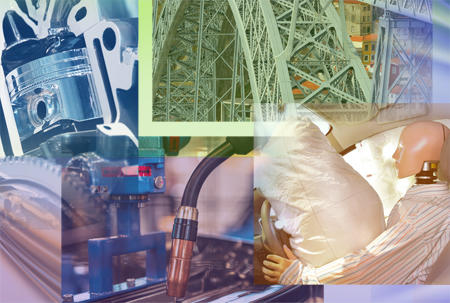
Crash-test dummies, yarn-spinning machines and steel girders in bridges. What do they have in common? Look inside them all and you find transducers, devices that measure the forces that push, pull, weigh upon and slam into them. But transducers also have something in common: Until recently, it was difficult to calibrate them in all but the simplest sense. Now, scientists at the National Institute of Standards and Technology (NIST) are changing that.
If you think of any device with moving parts, it's likely that it's larger, bulkier or heavier than it needs to be, and, therefore, probably requires more energy than it might. That's because engineers have lacked a good way to accurately measure dynamic forces—those that change over time—and so they over-design to compensate. It is difficult to standardize manufacturing and testing processes because measurements made with different transducer models generally do not agree with each other. Fast-changing forces like the shock waves felt in explosions and crashes are particularly difficult to measure accurately.
"It's surprising, but true; and it cuts across industries," says NIST physicist Ako Chijioke. "Measuring static forces is fairly easy. But once they start to change, it gets hard—and the faster they change, the harder it gets. So for a long time, designers often have had to over-engineer machines to make sure they can handle what we ask of them."
Chijioke has spent the past few years trying to solve this decades-old problem, and, with his colleagues, has recently finished building the first system* that would be widely available to industry that can put a transducer through enough paces to ensure that its force measurements are accurate. Its measurements are tied to the International System of Units (SI), and it is proving useful for exploring how well a transducer functions in a dynamic environment, and for a range of applications.
"Essentially, we place a transducer with a specific amount of weight on top of it onto our device, and then start shaking it," Chijioke says. "We begin vibrating it at 10 times per second, then increase it till it reaches 2,000 times per second. Depending on how thorough a manufacturer wants us to be across a range of weights and frequencies, calibration takes between an hour to a few days."
The new NIST system is similar to a system at the German national metrology institute** and others under development at a few other national metrology institutes, according to Chijioke. NIST intends to use the new system to create a dynamic calibration service that would be more convenient for American manufacturers, who could send their transducers directly to NIST for calibration.
"Calibration might, for example, improve the performance of complex machines that need to work together with others such as robot welders and manufacturing presses on assembly lines," Chijioke says. "But our efforts are likely to have ramifications that we and industry are just beginning to consider. A lot of the issues related to dynamic metrology are currently being worked out, and the field is still developing."
Companies interested in having NIST dynamically calibrate their transducers should contact Rick Seifarth at ricky.seifarth [at] nist.gov (ricky[dot]seifarth[at]nist[dot]gov) or (301) 975-6652.
*Chijioke spoke about his work at the NCSLI Conference at 11:30 a.m., July 29, 2014, in Orlando, Fla.
**Physikalisch-Technische Bundesanstalt, www.ptb.de/index_en.html
***Full Fotolia credits: Fotolia_41800044_largemeeting_©Alessandro_Capuzzo-Fotolia_com // Fotolia_56649320_robotwelder_©svedoliver-Fotolia_com // Fotolia_45763011_pistons2_©mediagram-Fotolia_com // Fotolia_61687463_ironbridge_©kulikovv-Fotolia_com // Fotolia_25345207_crashtest_dummy_©Dmitry_Vereshchagin-Fotolia_com // Fotolia_55555468_piston_engine_©joel_420-Fotolia_com // Fotolia_53969437_bridgesupports_©V_ZHURAVLEV-Fotolia_com

